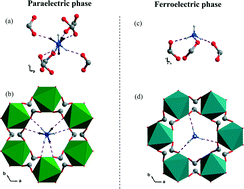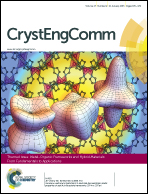Elastic properties and acoustic dissipation associated with a disorder–order ferroelectric transition in a metal–organic framework†
Abstract
Elastic properties and acoustic dissipation associated with the disorder–order ferroelectric transition in a single crystal metal–organic framework (MOF), [NH4][Zn(HCOO)3], have been investigated using resonant ultrasound spectroscopy (RUS) in the temperature range between 10 K and 300 K. The paraelectric to ferroelectric transition at around 192 K is triggered by the disorder–order transition of ammonium cations within the structure and changes of hydrogen bonding, accompanied by a structural phase transition from the non-polar hexagonal space group P6322 to the polar hexagonal space group P63. The elastic moduli, which are proportional to the square of resonant frequencies, gradually decrease with increasing temperature, and the rate of decrease changes markedly near the transition temperature. The acoustic dissipation tends to gradually increase with increasing temperature, but with a peak near the transition point. This pattern of behaviour can be understood by analogy with phase transitions driven by hydrogen bonding coupled to lattice strain in the mineral lawsonite [CaAl2Si2O7(OH)2·H2O]. The newly formed hydrogen bonds act as braces to stiffen the structure, as opposed to the elastic softening which typically occurs at displacive phase transitions. The acoustic loss mechanism involves dynamical disordering of hydrogen atoms between symmetry related positions and coupling of their motion with local lattice strain.

- This article is part of the themed collections: In celebration of Tony Cheetham’s 70th birthday and Metal-Organic Frameworks and Hybrid Materials

 Please wait while we load your content...
Please wait while we load your content...